Hyperspectral Remote Sensing for Early Detection of Wheat Leaf Rust Caused by Puccinia triticina
Abstract
1. Introduction
2. Materials and Methods
2.1. Plant Material Preparation
2.2. Hyperspectral Camera Setup
2.3. Image Acquisition
2.4. Gas Chromatography-Mass Spectrometry GC-MS Analysis
2.5. VIS-NIR Spectroscopy
3. Results
3.1. Data Classification Results
- (a)
- Hyperspectral curves analysis. The first stage of data analysis was plotting hyperspectral curves [20,21]. The results obtained demonstrated similarity with the results of consimilar studies on the topic [20,22,23]. Hyperspectral curves were typical for plant objects. It was concluded that hyperspectral imaging was carried out correctly and its results could be used for further research. The spectral curves are shown in Figure 2.
- (b)
- Pixel distributions analysis. The second stage of data analysis was the search for correlated-value cluster presence and complex intensity distributions. Since hyperspectral images are inherently similar to conventional images and are a set of two-dimensional matrices, the data were analyzed in terms of correlated-value cluster presence and complex intensity distributions before classification methods choosing. The distributions were analyzed for all available wavelengths in the range of 440–870 nm. Visual hyperspectral images analysis did not demonstrate significant differences in pixel distributions, in which the control group would differ from wheat leaf rust inoculated group until 7 dai. Based on this observation, the use of neural network models to build a classification of hyperspectral images was not preferable for early disease detection. An example of wavelength matrices distributions for the 440 nm wavelength is shown in Figure 3.
- (c)
- Feature generation. Next, an analysis of class separability (control or experiment data) was made based on various features that could be extracted from hyperspectral images. For each available hyperspectral range, two groups of features have been calculated. The first group of features are mean values of pixel for each range. The second group are textural features for each range [24]. Homogeneity, contrast, dissimilarity and entropy have been chosen as texture features based on results from [20,25]. The average value usage for each range as a predictor was made due to an assumption that the reflectivity of diseased and healthy plants is generally different. The use of textural features was based on an assumption that control or experiment data can be different in terms of heterogeneity of their structure in certain ranges.
- (d)
- Preliminary analysis of separability of classes in the attribute space. To display classes in the feature space, the t-Distributed Stochastic Neighbor Embedding algorithm (t-SNE) presented in [26] was used. The algorithm is a modification of the Stochastic Neighbor-Embedding (SNE) algorithm presented in [27]. Both algorithms make it possible to map a multidimensional space onto a space of smaller dimensions, for example, a two-dimensional one. The difference of the t-SNE algorithm is that it uses a different cost function, which allows to simplify the original SNE optimization problem. T-SNE representations for different feature spaces is shown in Figure 4.
3.2. Metabolomic Analysis Results
4. Discussion
5. Conclusions
Supplementary Materials
Author Contributions
Funding
Data Availability Statement
Conflicts of Interest
Abbreviations
| ANN | Artificial Neural Network |
| ARI | Anthocyanin Reflectance Index |
| CNN | Convolutional Neural Network |
| GC-MS | Gas Chromatography-Mass Spectrometry |
| GI | Greenness Index |
| LSD | Least Significant Difference |
| MLP–ARD | Multilayer Perceptron with Automated Relevance Determination |
| NBNDVI | Narrow-Band Normalized Difference Vegetation Index |
| NDVI | Normalized Difference Vegetation Index |
| PRI | Photochemical Reflectance Index |
| VIS-NIR | Visible/Near Infrared |
| SNE | Stochastic Neighbor Embedding algorithm |
| SVM | Support Vector Machine |
| SWIR | Short Wave Infrared |
| TIFF | Tag Image File Format |
| t-SNE | t-Distributed Stochastic Neighbor Embedding algorithm |
| UAV | Unmanned Aerial Vehicle |
References
- Gebbers, R.; Adamchuk, V. Precision agriculture and food security. Science 2010, 327, 828–831. [Google Scholar] [CrossRef]
- Shafi, U.; Mumtaz, R.; García-Nieto, J.; Hassan, S.A.; Zaidi, S.A.R.; Iqbal, N. Precision Agriculture Techniques and Practices: From Considerations to Applications. Sensors 2019, 19, 3796. [Google Scholar] [CrossRef]
- Bolton, M.; Kolmer, J.; Garvin, D. Wheat leaf rust caused by Puccinia triticina. Mol. Plant Patol 2008, 9, 563–575. [Google Scholar] [CrossRef]
- Huerta-Espino, J.; Singh, R.P.; German, S.; McCallum, B.D.; Park, R.F.; Chen, W.Q.; Bhardwaj, S.C.; Goyeau, H. Global status of wheat leaf rust caused by Puccinia triticina. Euphytica 2011, 179, 143–160. [Google Scholar] [CrossRef]
- Gultyaeva, E.; Shaydayuk, E.; Gannibal, P. Leaf Rust Resistance Genes in Wheat Cultivars Registered in Russia and Their Influence on Adaptation Processes in Pathogen Populations. Agriculture 2021, 11, 319. [Google Scholar] [CrossRef]
- Mahlein, A.K.; Kuska, M.T.; Thomas, S.; Bohnenkamp, D.; Alisaac, E.; Behmann, J.; Wahabzada, M.; Kersting, K. Plant disease detection by hyperspectral imaging: From the lab to the field. Adv. Anim. Biosci. 2017, 8, 238–243. [Google Scholar] [CrossRef]
- Khan, A.; Vibhute, A.D.; Mali, S.; Pati, C.H. A systematic review on hyperspectral imaging technology with a machine and deep learning methodology for agricultural applications. Ecol. Inform. 2022, 69, 101678. [Google Scholar] [CrossRef]
- Terentev, A.; Dolzhenko, V.; Fedotov, A.; Eremenko, D. Current State of Hyperspectral Remote Sensing for Early Plant Disease Detection: A Review. Sensors 2022, 22, 757. [Google Scholar] [CrossRef] [PubMed]
- Wan, L.; Li, H.; Li, C.; Wang, A.; Yang, Y.; Wang, P. Hyperspectral Sensing of Plant Diseases: Principle and Methods. Agronomy 2022, 12, 1451. [Google Scholar] [CrossRef]
- Finger, R. No pesticide-free Switzerland. Nat. Plants 2021, 7, 1324–1325. [Google Scholar] [CrossRef]
- Moysiadis, V.; Sarigiannidis, P.; Vitsas, V.; Khelifi, A. Smart farming in Europe. Comput. Sci. Rev. 2021, 39, 100345. [Google Scholar] [CrossRef]
- Ashourloo, D.; Mobasheri, M.R.; Huete, A. Evaluating the Effect of Different Wheat Rust Disease Symptoms on Vegetation Indices Using Hyperspectral Measurements. Remote Sens. 2014, 6, 5107–5123. [Google Scholar] [CrossRef]
- Bohnenkamp, D.; Kuska, M.T.; Mahlein, A.K.; Behmann, J. Hyperspectral signal decomposition and symptom detection of wheat rust disease at the leaf scale using pure fungal spore spectra as reference. Plant Pathol. 2019, 68, 1188–1195. [Google Scholar] [CrossRef]
- Gold, K.M.; Townsend, P.A.; Chlus, A.; Herrmann, I.; Couture, J.J.; Larson, E.R.; Gevens, A.J. Hyperspectral Measurements Enable Pre-Symptomatic Detection and Differentiation of Contrasting Physiological Effects of Late Blight and Early Blight in Potato. Remote Sens. 2020, 12, 286. [Google Scholar] [CrossRef]
- Chen, J.; Saimi, A.; Zhang, M.; Liu, Q.; Ma, Z. Epidemic of Wheat Stripe Rust Detected by Hyperspectral Remote Sensing and Its Potential Correlation with Soil Nitrogen during Latent Period. Life 2022, 12, 1377. [Google Scholar] [CrossRef]
- Huang, L.; Liu, Y.; Huang, W.; Dong, Y.; Ma, H.; Wu, K.; Guo, A. Combining Random Forest and XGBoost Methods in Detecting Early and Mid-Term Winter Wheat Stripe Rust Using Canopy Level Hyperspectral Measurements. Agriculture 2022, 12, 74. [Google Scholar] [CrossRef]
- Liu, Y.; Zhang, Y.; Jiang, D.; Zhang, Z.; Chang, Q. Quantitative Assessment of Apple Mosaic Disease Severity Based on Hyperspectral Images and Chlorophyll Content. Remote Sens. 2023, 15, 2202. [Google Scholar] [CrossRef]
- Lichtenthaler, H.K.; Buschmann, C. Chlorophylls and Carotenoids: Measurement and Characterization by UV-VIS Spectroscopy. Curr. Protoc. Food Anal. Chem. 2001, 1, F4.3.1–F4.3.8. [Google Scholar] [CrossRef]
- Horprasert, T.; Harwood, D.; Davis, L.S. A statistical approach for real-time robust background subtraction and shadow detection. IEEE ICCV 1999, 99, 1–19. [Google Scholar]
- Guo, A.; Huang, W.; Ye, H.; Dong, Y.; Ma, H.; Ren, Y.; Ruan, C. Identification of Wheat Yellow Rust Using Spectral and Texture Features of Hyperspectral Images. Remote Sens. 2020, 12, 1419. [Google Scholar] [CrossRef]
- Mahlein, A.-K.; Alisaac, E.; Al Masri, A.; Behmann, J.; Dehne, H.-W.; Oerke, E.-C. Comparison and Combination of Thermal, Fluorescence, and Hyperspectral Imaging for Monitoring Fusarium Head Blight of Wheat on Spikelet Scale. Sensors 2019, 19, 2281. [Google Scholar] [CrossRef]
- Guo, A.; Huang, W.; Dong, Y.; Ye, H.; Ma, H.; Liu, B.; Wu, W.; Ren, Y.; Ruan, C.; Geng, Y. Wheat Yellow Rust Detection Using UAV-Based Hyperspectral Technology. Remote Sens. 2021, 13, 123. [Google Scholar] [CrossRef]
- Zhang, X.; Han, L.; Dong, Y.; Shi, Y.; Huang, W.; Han, L.; González-Moreno, P.; Ma, H.; Ye, H.; Sobeih, T. A Deep Learning-Based Approach for Automated Yellow Rust Disease Detection from High-Resolution Hyperspectral UAV Images. Remote Sens. 2019, 11, 1554. [Google Scholar] [CrossRef]
- Haralick, R.M.; Shanmugam, K.; Dinstein, I.H. Textural features for image classification. IEEE Trans. Syst. Man Cybern. 1973, 6, 610–621. [Google Scholar] [CrossRef]
- Xuan, G.; Li, Q.; Shao, Y.; Shi, Y. Early Diagnosis and Pathogenesis Monitoring of Wheat Powdery Mildew Caused by Blumeria Graminis Using Hyperspectral Imaging. Comput. Electron. Agric. 2022, 197, 106921. [Google Scholar] [CrossRef]
- Van der Maaten, L.; Hinton, G. Visualizing data using t-SNE. J. Mach. Learn. Res. 2008, 9, 2579–2605. [Google Scholar]
- Hinton, G.E.; Roweis, S.T. Stochastic neighbor embedding. Adv. Neural Inf. Process. Syst. 2002, 15, 857–864. [Google Scholar]
- Cortes, C.; Vapnik, V. Support-Vector Networks. Mach. Learn. 1995, 20, 273–297. [Google Scholar] [CrossRef]
- Available online: https://scikit-learn.org/stable/modules/svm.html (accessed on 1 January 2023).
- Ube, N.; Harada, D.; Katsuyama, Y.; Osaki-Oka, K.; Tonooka, T.; Ueno, K.; Taketa, S.; Ishihara, A. Identification of phenylamide phytoalexins and characterization of inducible phenylamide metabolism in wheat. Phytochemistry 2019, 167, 112098. [Google Scholar] [CrossRef]
- Ube, N.; Yabuta, Y.; Tohnooka, T.; Ueno, K.; Taketa, S.; Ishihara, A. Biosynthesis of Phenylamide Phytoalexins in Patho-gen-Infected Barley. Int. J. Mol. Sci. 2019, 20, 5541. [Google Scholar] [CrossRef]
- Curran, P.J. Remote sensing of foliar chemistry. Remote Sens. Environ. 1989, 30, 271–278. [Google Scholar] [CrossRef]
- Jacquemoud, S.; Ustin, S. Leaf optical properties in different wavelength domains. In Leaf Optical Properties; Jacquemoud, S., Ustin, S., Eds.; Cambridge University Press: Cambridge, UK, 2019; pp. 124–169. [Google Scholar]
- Blackburn, G.A. Quantifying Chlorophylls and Caroteniods at Leaf and Canopy Scales. Remote Sens. Environ. 1998, 66, 273–285. [Google Scholar] [CrossRef]
- Mahlein, A.K.; Kuska, M.T.; Behmann, J.; Polder, G.; Walter, A. Hyperspectral sensors and imaging technologies in phyto-pathology: State of the art. Annu. Rev. Phytopathol. 2018, 56, 535–558. [Google Scholar] [CrossRef]
- Bouguettaya, A.; Zarzour, H.; Kechida, A.; Taberkit, A.M. A survey on deep learning-based identification of plant and crop diseases from UAV-based aerial images. Cluster Comput. 2023, 26, 1297–1317. [Google Scholar] [CrossRef]
- Chen, F.; Ma, R.; Chen, X.-L. Advances of Metabolomics in Fungal Pathogen–Plant Interactions. Metabolites 2019, 9, 169. [Google Scholar] [CrossRef]
- Castro-Moretti, F.R.; Gentzel, I.N.; Mackey, D.; Alonso, A.P. Metabolomics as an Emerging Tool for the Study of Plant–Pathogen Interactions. Metabolites 2020, 10, 52. [Google Scholar] [CrossRef]
- Brugger, A.; Yamati, F.I.; Barreto, A.; Paulus, S.; Schramowsk, P.; Kersting, K.; Steiner, U.; Neugart, S.; Mahlein, A.-K. Hyperspectral Imaging in the UV Range Allows for Differentiation of Sugar Beet Diseases Based on Changes in Secondary Plant Metabolites. Phytopathology 2023, 113, 44–54. [Google Scholar] [CrossRef]
- Behmann, J.; Mahlein, A.-K.; Rumpf, T.; Römer, C.; Plümer, L. A review of advanced machine learning methods for the detection of biotic stress in precision crop protection. Precis. Agric. 2015, 16, 239–260. [Google Scholar] [CrossRef]
- Xue, J.; Su, B. Significant remote sensing vegetation indices: A review of developments and applications. J. Sens. 2017, 2017, 1353691. [Google Scholar] [CrossRef]
- Golhani, K.; Balasundram, S.K.; Vadamalai, G.; Pradhan, B. A review of neural networks in plant disease detection using hyperspectral data. Inf. Process. Agric. 2018, 5, 354–371. [Google Scholar] [CrossRef]
- Ngugi, L.C.; Abelwahab, M.; Abo-Zahhad, M. Recent Advances in Image Processing Techniques for Automated Leaf Pest and Disease Recognition—A Review. Inf. Process. Agric. 2020, 8, 27–51. [Google Scholar] [CrossRef]
- Alisaac, E.; Behmann, J.; Kuska, M.T.; Dehne, H.-W.; Mahlein, A.-K. Hyperspectral quantification of wheat resistance to Fusarium head blight: Comparison of two Fusarium species. Eur. J. Plant Pathol. 2018, 152, 869–884. [Google Scholar] [CrossRef]
- Huang, L.; Zhang, H.; Ruan, C.; Huang, W.; Hu, T.; Zhao, J. Detection of scab in wheat ears using in situ hyperspectral data and support vector machine optimized by genetic algorithm. Int. J. Agric. Biol. Eng. 2020, 13, 182–188. [Google Scholar] [CrossRef]
- Morellos, A.; Tziotzios, G.; Orfanidou, C.; Pantazi, X.E.; Sarantaris, C.; Maliogka, V.; Alexandridis, T.K.; Moshou, D. Non-Destructive Early Detection and Quantitative Severity Stage Classification of Tomato Chlorosis Virus (ToCV) Infection in Young Tomato Plants Using Vis–NIR Spectroscopy. Remote Sens. 2020, 12, 1920. [Google Scholar] [CrossRef]
- Baek, I.; Kim, M.S.; Cho, B.K.; Mo, C.; Barnaby, J.Y.; McClung, A.M.; Oh, M. Selection of Optimal Hyperspectral Wavebands for Detection of Discolored, Diseased Rice Seeds. Appl. Sci. 2019, 9, 1027. [Google Scholar] [CrossRef]
- Nagasubramanian, K.; Jones, S.; Singh, A.K.; Sarkar, S.; Singh, A.; Ganapathysubramanian, B. Plant disease identification using explainable 3D deep learning on hyperspectral images. Plant Methods 2019, 15, 98. [Google Scholar] [CrossRef]
- Polder, G.; Blok, P.M.; de Villiers, H.A.C.; van der Wolf, J.M.; Kamp, J. Potato Virus Y Detection in Seed Potatoes Using Deep Learning on Hyperspectral Images. Front. Plant Sci. 2019, 10, 209. [Google Scholar] [CrossRef]
- Gomez Villa, A.; Salazar, A.; Vargas, F. Towards automatic wild animal monitoring: Identification of animal species in camera-trap images using very deep convolutional neural networks. Ecol. Inform. 2017, 41, 24–32. [Google Scholar] [CrossRef]
- Buetti-Dinh, A.; Galli, V.; Bellenberg, S.; Ilie, O.; Herold, M.; Christel, S.; Boretska, M.; Pivkin, I.V.; Wilmes, P.; Sand, W.; et al. Deep Neural Networks Outperform Human Expert’s Capacity in Characterizing Bioleaching Bacterial Biofilm Composition. Biotechnol. Rep. 2019, 22, e00321. [Google Scholar] [CrossRef]
- Ke, G.L.; Meng, Q.; Finley, T.; Wang, T.F.; Chen, W.; Ma, W.D.; Ye, Q.W.; Liu, T.Y. LightGBM: A highly efficient gradient boosting decision tree. In Proceedings of the 31st Annual Conference on Neural Information Processing Systems, Long Beach, CA, USA, 4–9 December 2017; pp. 3146–3154. [Google Scholar]
- Prokhorenkova, L.; Gusev, G.; Vorobev, A.; Dorogush, A.V.; Gulin, A. CatBoost: Unbiased boosting with categorical features. In Proceedings of the 32nd International Conference on Neural Information Processing Systems, Montréal, QC, Canada, 3–8 December 2018; pp. 6639–6649. [Google Scholar]

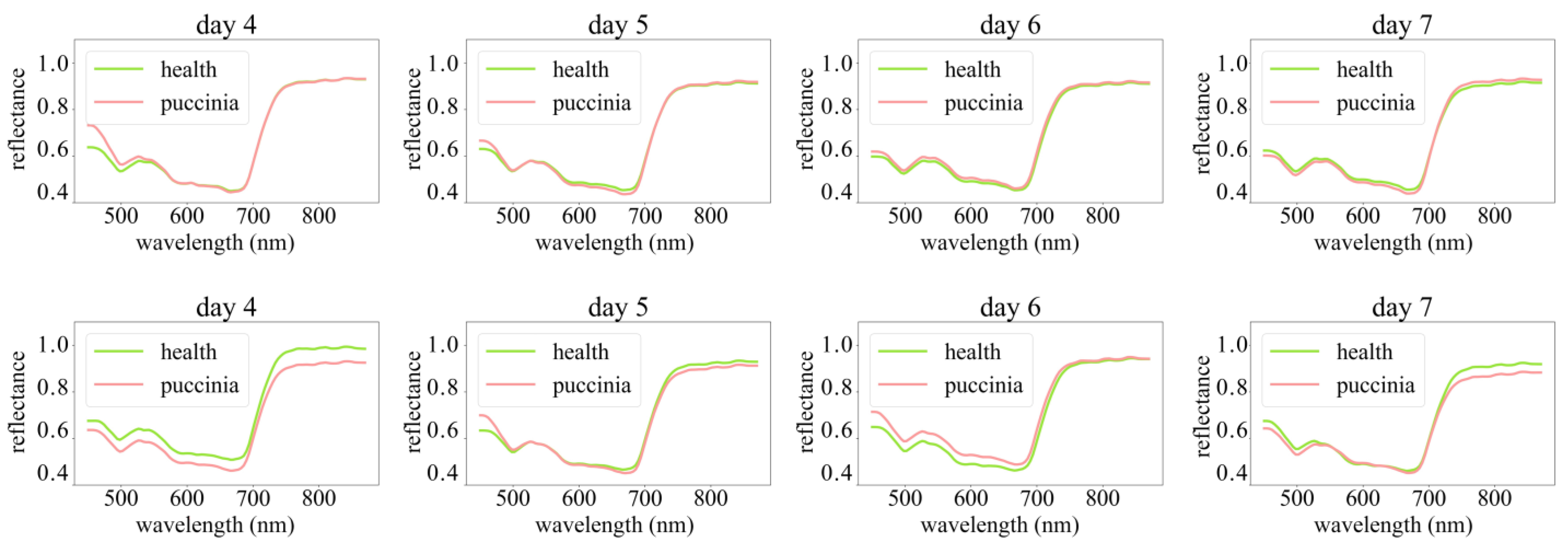
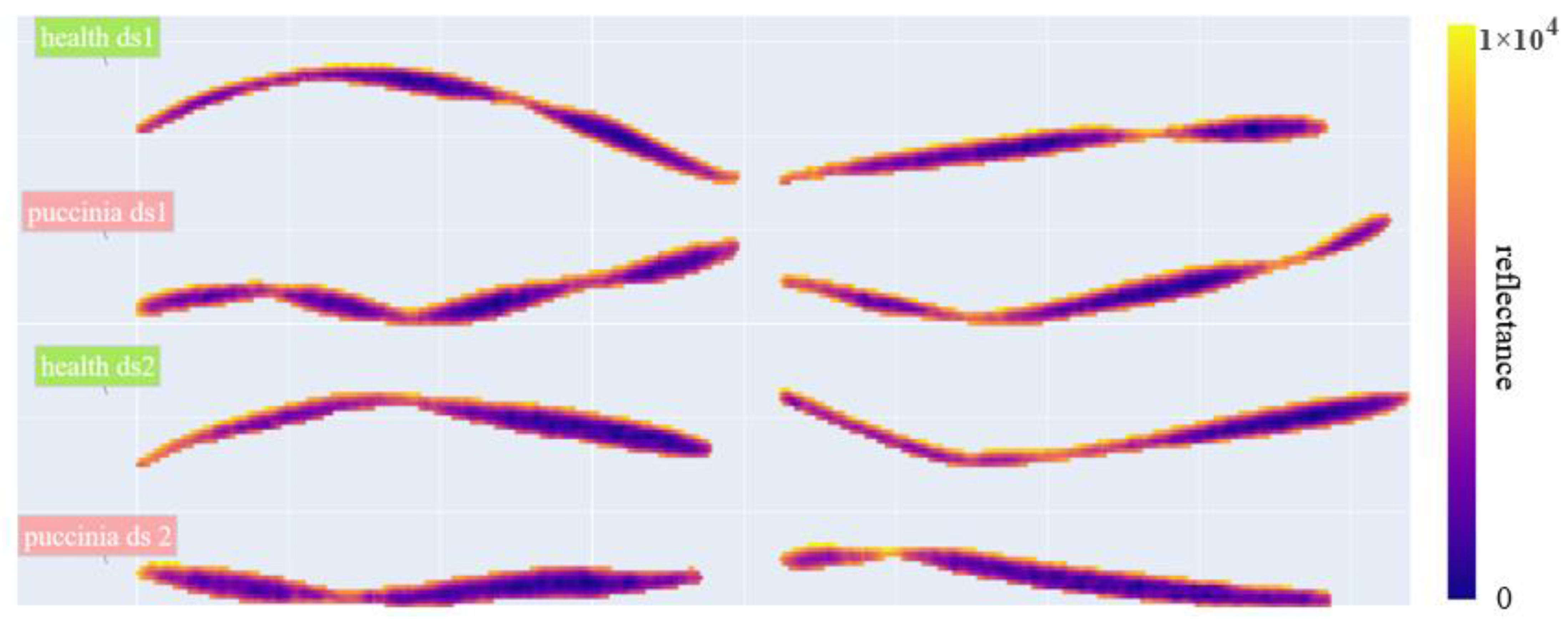

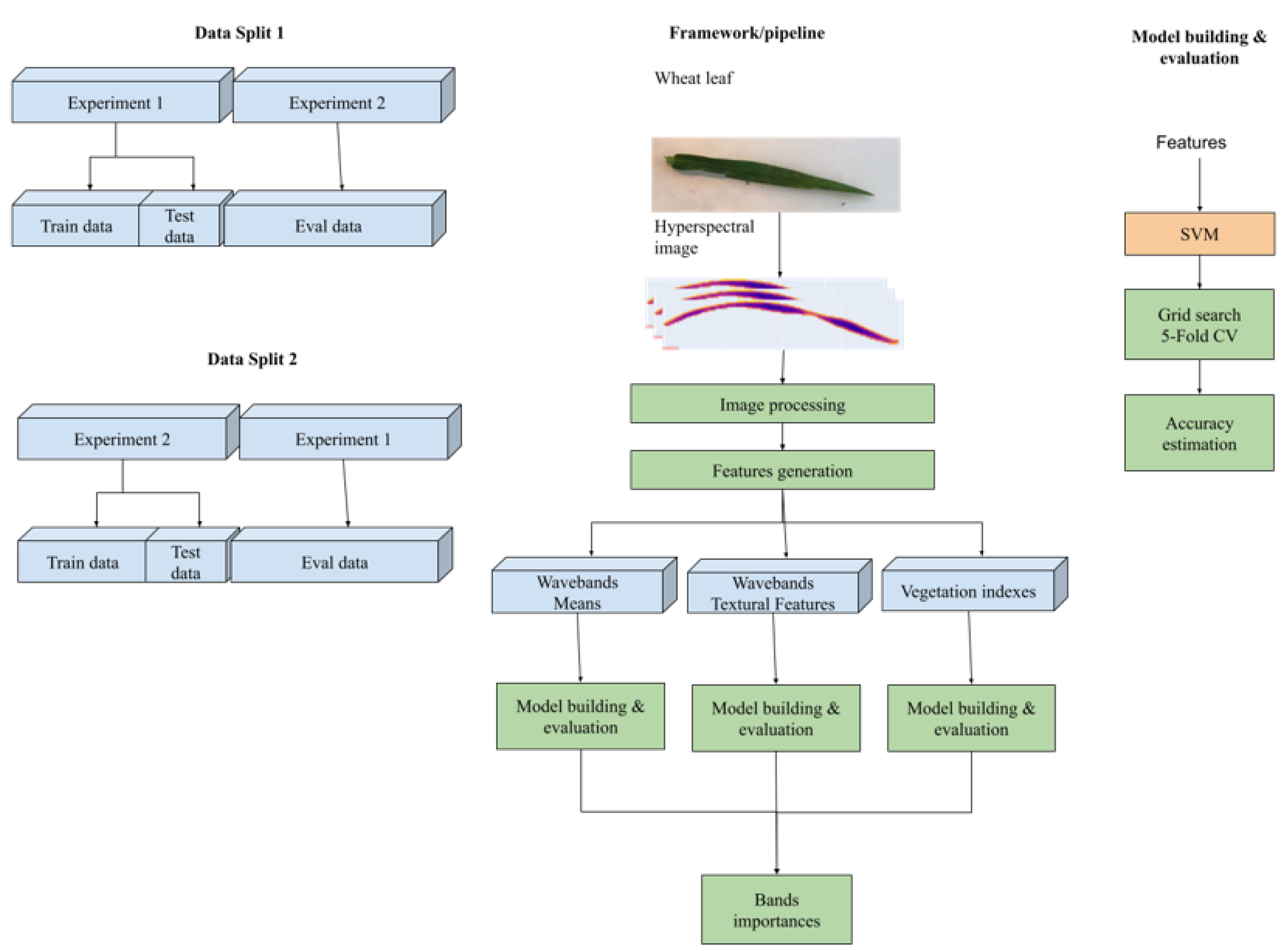



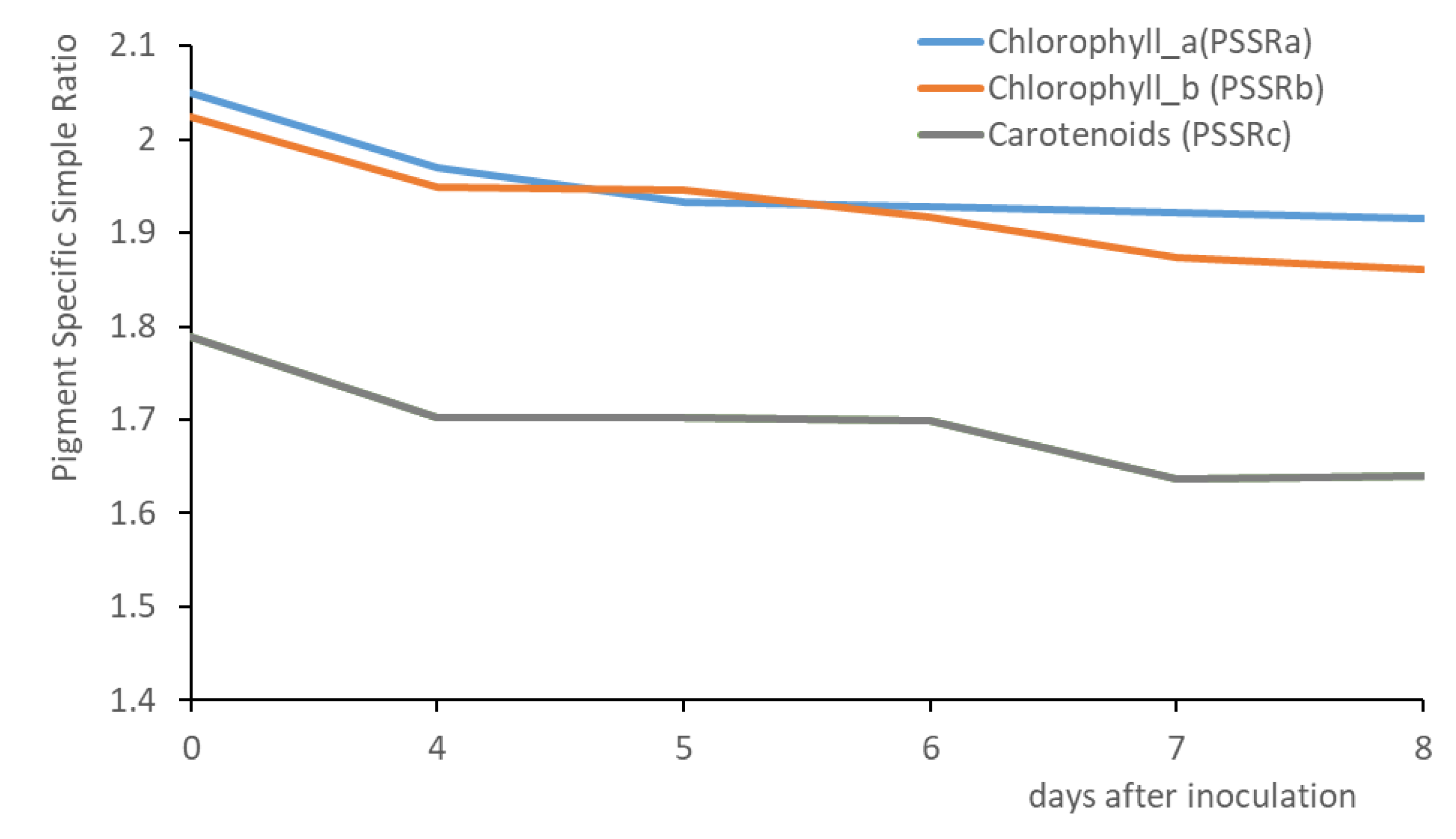
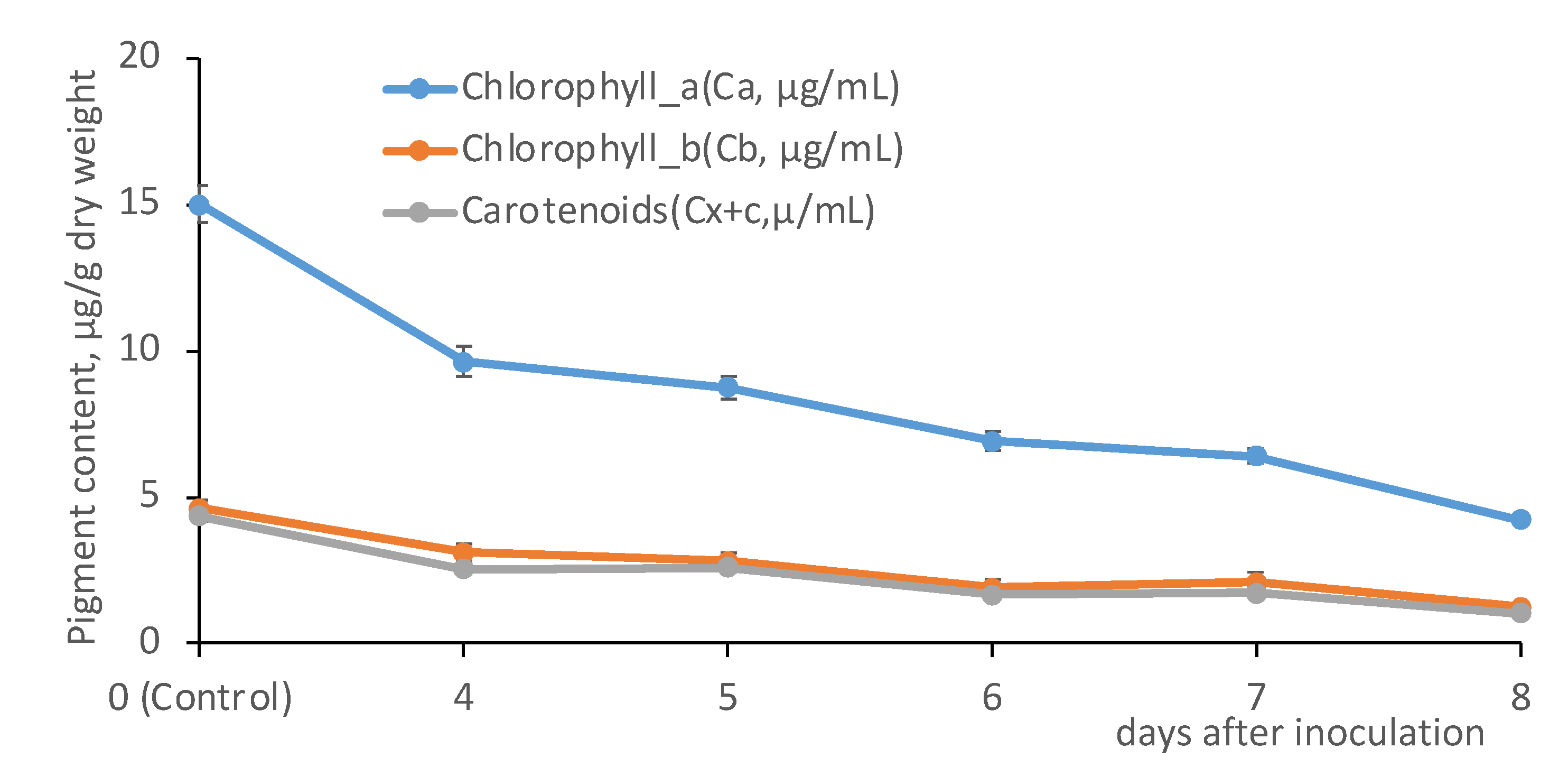
| Author and Reference | Sensor Used | Sensor Type | Spectral Range | Algorithm Used | Results | Early Detection |
|---|---|---|---|---|---|---|
| Ashourloo et al. [12] | ASD Fieldspec 4 pro | whisk-broom camera | 350–2500 nm. | NBNDVI, NDVI, PRI, GI, and RVSI | >70% accuracy | No |
| Bohnenkamp et al. [13] | ImSpector PFD V10E | snapshot camera | 400–1000 nm. | Least-squre factorization | Not mentioned | No |
| Dataset | Model | Parameters | Features | Training | Testing | Evaluation | |||
|---|---|---|---|---|---|---|---|---|---|
| OA% | Kappa | OA% | Kappa | OA% | Kappa | ||||
| set 1 | SVM | C = 1 kernel = linear | MEAN | 100.0 | 1.00 | 99.0 | 0.98 | 98.0 | 0.97 |
| C = 1000 kernel = linear | TF | 100.0 | 1.00 | 98.0 | 0.97 | 97.0 | 0.94 | ||
| C = 1000 gamma = 0.1 kernel = rbf | INDEXES | 100.0 | 0.99 | 98.0 | 0.97 | 0.94 | 0.88 | ||
| C = 1000 gamma = 0.0001 kernel = linear | MEAN + TF | 100.0 | 1.00 | 100.0 | 1.00 | 98.0 | 0.96 | ||
| set 2 | SVM | C = 1 kernel = linear | MEAN | 100.0 | 1.00 | 100.0 | 1.00 | 98.0 | 0.97 |
| C = 100 gamma = 0.001 kernel = rbf | TF | 100.0 | 1.00 | 98.0 | 0.95 | 95.0 | 0.90 | ||
| C = 1000 kernel = linear | INDEXES | 99.0 | 0.99 | 98.0 | 0.97 | 94.0 | 0.88 | ||
| C = 100 gamma = 0.0001 kernel = linear | MEAN + TF | 99.0 | 0.99 | 98.0 | 0.95 | 93.0 | 0.86 | ||
Disclaimer/Publisher’s Note: The statements, opinions and data contained in all publications are solely those of the individual author(s) and contributor(s) and not of MDPI and/or the editor(s). MDPI and/or the editor(s) disclaim responsibility for any injury to people or property resulting from any ideas, methods, instructions or products referred to in the content. |
© 2023 by the authors. Licensee MDPI, Basel, Switzerland. This article is an open access article distributed under the terms and conditions of the Creative Commons Attribution (CC BY) license (https://creativecommons.org/licenses/by/4.0/).
Share and Cite
Terentev, A.; Badenko, V.; Shaydayuk, E.; Emelyanov, D.; Eremenko, D.; Klabukov, D.; Fedotov, A.; Dolzhenko, V. Hyperspectral Remote Sensing for Early Detection of Wheat Leaf Rust Caused by Puccinia triticina. Agriculture 2023, 13, 1186. https://doi.org/10.3390/agriculture13061186
Terentev A, Badenko V, Shaydayuk E, Emelyanov D, Eremenko D, Klabukov D, Fedotov A, Dolzhenko V. Hyperspectral Remote Sensing for Early Detection of Wheat Leaf Rust Caused by Puccinia triticina. Agriculture. 2023; 13(6):1186. https://doi.org/10.3390/agriculture13061186
Chicago/Turabian StyleTerentev, Anton, Vladimir Badenko, Ekaterina Shaydayuk, Dmitriy Emelyanov, Danila Eremenko, Dmitriy Klabukov, Alexander Fedotov, and Viktor Dolzhenko. 2023. "Hyperspectral Remote Sensing for Early Detection of Wheat Leaf Rust Caused by Puccinia triticina" Agriculture 13, no. 6: 1186. https://doi.org/10.3390/agriculture13061186
APA StyleTerentev, A., Badenko, V., Shaydayuk, E., Emelyanov, D., Eremenko, D., Klabukov, D., Fedotov, A., & Dolzhenko, V. (2023). Hyperspectral Remote Sensing for Early Detection of Wheat Leaf Rust Caused by Puccinia triticina. Agriculture, 13(6), 1186. https://doi.org/10.3390/agriculture13061186







